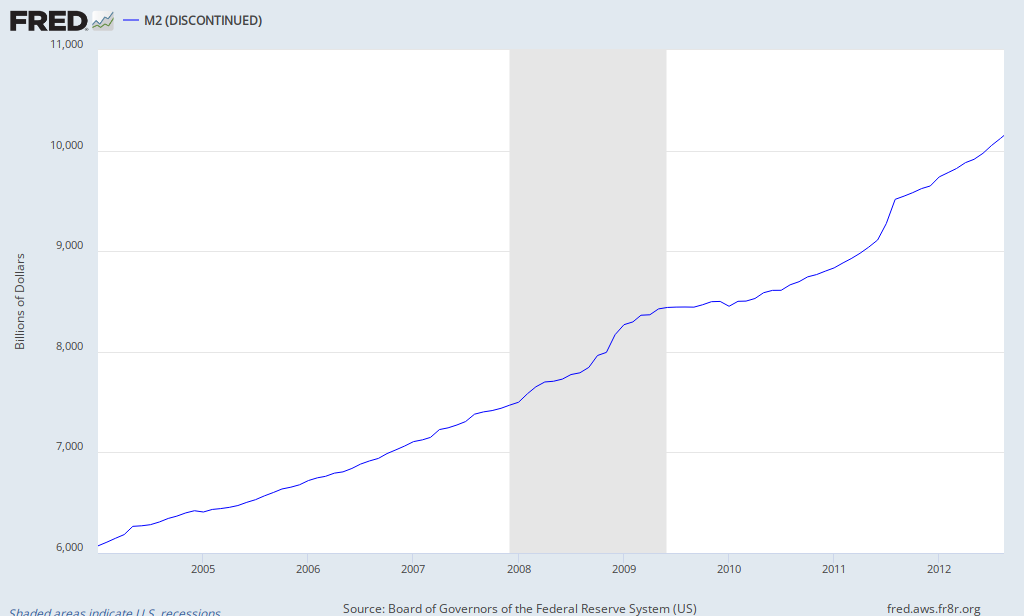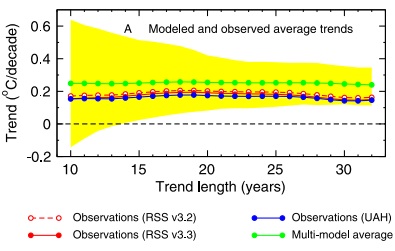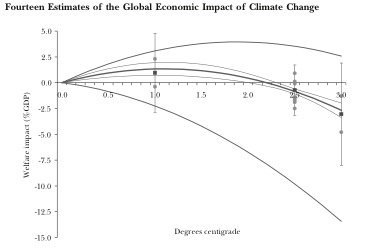[NB: See the
UPDATE at the bottom of this post.]
Following our previous
tête-à-tête on the
Heartland Affair, here's a response to Bob Murphy's latest post on climate change.
In the interests of keeping this as a brief as possible, let me just say
that my post follows a back-and-forth involving different groups of people. My aim here isn't to give an overview to the entire discussion, but
rather to reply directly to Bob's key points. However, the four act summary is as follows...
- ACT 1: A group of 16 self-proclaimed climate skeptics write an op-ed in the Wall Street Journal, "No need to panic about global warming".
- ACT 2: William Nordhaus, professor at Yale University and one of the founding fathers of climate change economics, pens a widely cited essay in response, “Why the Global Warming Skeptics Are Wrong.” Among other things, Nordhaus takes umbrage with the fact that these skeptics have bungled his own research in trying to argue that climate change is not cause for concern.
- ACT 3: Enter Bob Murphy, who comes to defend the honour of the original skeptics in his article, "What Nordhaus Gets Wrong".
- FINAL ACT:
Stickman Grant McDermott sweeps in from the shadows to set right the wrongs of the blogging world. Order is restored, women swoon and the sound of childrens' laughter fills the air. Murphy curses and retreats to his secret lair, vowing revenge.
Now that you've seen the plot spoiler, let's go through some details:
1) Global Temperatures Have Been Flat for a Decade
Bob claims that Nordhaus is using a rhetorical slight of hand in addressing the skeptic claim that global temperatures have not increased in 10 years. Nordhaus does this by referring to the instrumental temperature record, which dates back to the 19th century and shows a clear warming trend. Bob claims that this isn't fair, since "no warming in the last decade" and "no warming since 1880" are different statements.
To be frank, this is simply dancing around the issue. If the original claim was meant to serve no purpose beyond itself, then perhaps that would be okay. (Vacuous, but okay.) However, the implication and inference of the skeptics' original statement was abundantly clear: Global warming has stopped, so all this talk about dangerous increases in future temperatures is probably bunk.[*] Nordhaus rightly points out that this is a meaningless observation and that only
long-term trends can provide proper context. However, Bob tries to head off this approach too, by providing a long-term graph with rescaled Y-axis; ostensibly to show that temperatures have hardly changed in absolute terms over the last 150 years.
This is simply disingenuous. Let's conduct a simple thought experiment to show why. Imagine that observed warming since the Industrial Revolution
isn't caused by mankind, but rather some combination of natural factors. Let's posit that the observed long-term trend due to this natural forcing trend continues unabated, so that temperatures eventually exceed pre-industrial levels by more than
2°C. Will there be economic costs associated with this, relative to a world without warming? Well, according to virtually every single study on the matter, the answer is a clear "YES". If it wasn't, then we wouldn't even be having this discussion... Why do you think
adaptation through economic growth is taken so seriously -- not least of all, by prominent contrarians? (Also, see #3 below.)
The take home message is this: Seemingly small changes on the global scale will have tremendous impacts on the climate and natural systems that we depend on. For instance, a 3
°C rise in average global temps will correspond to a world that probably hasn't existed for millions of years, entailing massive unknowns and downside risks. Further, the changes in
regional temperatures will actually be far more acute,
even if these "balance out" to some extent at a global level. (This point is often sadly overlooked by the focus on global averages.)
2) Actual Global Warming Has Been Smaller Than What the Models Predicted
Bob largely bases his comments here on a
Master Resource blog post, which in turn cites a paper by
Santer et al. (2011). Now, the main purpose of this study is quite technical in that it aims to show how different timescales can affect the ability to distinguish between climate "noise" and "signal". (Ironically, their bottom line is that we gain no understanding of climate change drivers simply by looking at the
temperature record from a single decade.) However, we don't really need to concern ourselves with that here. The relevant issue -- and the one that Bob limits his discussion to -- relates to the below graph. It shows temperature measurements of the lower troposphere (TLT), as "observed" by two satellites (RSS and UAH) and predicted by climate models. Without going into specific details, Bob uses this as evidence to suggest that climate models exaggerate the warming effect in comparison to what reality will turn up.
Allow me to make two comments in response. The first thing to note is that satellite temperature measurements appear to suffer from an unresolved cooling bias.[**] Santer
et al. (ibid, p. 10) actually highlight this issue in their paper:
“Given the considerable technical challenges involved in adjusting
satellite-based estimates of TLT changes for inhomogeneities [Mears et
al., 2006, 2011b], a residual cool bias in the observations cannot be
ruled out, and may also contribute to the offset between the model and
observed average TLT trends.”
In other words, the observed temperatures in the above graph are probably lower than they "should" be. Santer
et al. go on to list a bunch of other factors that could also explain the
(slight) difference between these satellite measurements and the model predictions. I wish to emphasise that this difference is, indeed, "slight". More fundamentally, this relates to my second point: The models are still remarkably accurate. Again, let's turn to the actual paper (p.10):
“There is no timescale on which observed trends are statistically unusual (at the 5% level or better) relative to the
multimodel sampling distribution of forced TLT trends. We conclude from
this result that there is no inconsistency between observed near-global
TLT trends[...] and model estimates of the response to anthropogenic forcing.”
Translation: The models have performed exactly within the bounds of what we would hope for. I find it...
interesting that Chip Knappenberger (author of the MR post) chooses to ignore these caveats and findings, instead offering his readership an alternative conclusion that the models are on the "verge of failing". But then what do Santer & co. know? I mean, they just authored the study.
As for the assertion that Nordhaus is arguing against a strawman by focusing on the role that human activity has played in driving climate change, versus the alternative (weaker?) claim that the models have simply overestimated warming full stop... Let's consider the original WSJ op-ed again:
"The lack of warming for more than a decade[...] suggests that computer models have greatly exaggerated how much warming additional CO2 can cause." (Emphasis added.) You could perhaps argue that the statement is ambiguous, but I certainly don't think that Nordhaus is unjustified in highlighting the fact that, only by including CO2 alongside natural forcings, can we square model predictions with observed warming.
For more on the track record of computer models in predicting actual climate outcomes (including reconstructions of the past), see
here.
3) CO2 Is Not a Pollutant / CO2 Poses No Harm to Humans
Now we get down to actual economics. Bob declares his unwillingness to wade into a semantic battle of how we define a pollutant... A smart move on his part, since defending the banal assertion that
"CO2 can't be harmful because we, like, exhale it and stuff" -- a point that the WSJ skeptics effectively make -- could only lead to much wailing and gnashing of teeth. Instead, he thinks that he's caught Nordhaus at his own game by taking a deeper look at a study that he (i.e. Nordhaus) references in support of his arguments. The paper in question is a literature survey by Richard Tol (2009) entitled
"The Economic Effect of Climate". The key figure is below, which Bob uses to claim that CO2 rise will bring net benefits; at least up until two degrees warming.
[UPDATE: Bob Ward points out several typos in Tol's paper, which would bring the onset of (expected) negative effects forward. See here for an updated version of the below figure on the And Then There's Physics blog.]
Now, Bob is qualitatively correct here; several studies indicate that there are net gains to be had from some moderate level of warming. (Incidentally, this is not something that Nordhaus would appear to dispute.) There are several reasons for such benefits, including increased agricultural production in certain parts of the world. However, some crucial points must be emphasised:
- Look at the graph and tell me where your "ideal" temperature increase lies. The answer should be obvious: Around 1°C, since this is where we maximise welfare. Anything beyond that and you are doing worse than you would at the 1°C optimum.
- The build-up of CO2 is characterised by tremendous inertia. Similarly, it takes thousands of years for CO2 released into the atmosphere to return to natural sinks. Of course, you would also need to consider the structural barriers and delays involved in reorganising your economy away from fossil fuels...
- Simply put, you almost certainly need to establish a carbon price long before you reach the 1°C turning point... let alone the sharp negative effects that we expect beyond 2°C. Tol actually highlights this in his paper (p. 34): "Policy steps to reduce emissions of greenhouse gases in the near future would begin to have a noticeable affect on climate sometime around mid-century — which is to say, at just about the time that any medium-run economic benefits of climate change begin to decline." To his credit, Bob acknowledges these issues... albeit in a footnote. To my mind, this is such a fundamental matter that I can't help but think that it deserves more than footnote status. (I'd also like to know how he squares these issues with his conclusion that immediate mitigation efforts -- presumably the beginning of some carbon price -- should be cast in "serious doubt".)
Another reason to be
very cautious about the benefits of unimpeded CO2 emissions include disproportionately large downside risks (i.e. "fat tails") and, indeed, even regular loss aversion. If someone offers you the chance to flip a coin so that you either win $10,000 with 50% probability, or lose $9,500 with 50% probability, would you take it? I suspect that a clear majority of people would decline to take part in such a game of chance, even though the expected value is positive (i.e. $250). The idea that people value losses more than gains is very
well established in the theoretical and empirical literature. Lastly, we would also need to consider the regional disparities in any presumed gains. Africa, for instance stands to be the big loser from climate change, while Eastern Europe wins due to increased agricultural output. Needless to say, this throws up some very thorny ethical issues around the potential benefits that some countries might enjoy at the expense of others.
4) Nordhaus’ Own Work Shows Harms of Government Intervention
Okay, Bob is quick to say that the WSJ skeptics "screwed up" here. Anyone that has read Nordhaus's work knows that he as long called for Governments to put a price on carbon. Still, Bob now offers up one of this own papers to show that... well, it would seem that changing various factors in a climate model can lead to substantially different results. To be honest, I'm not entirely sure what to do with this. Admittedly, I haven't read Bob's paper -- I'll hopefully do so when I get time -- but in his blog post at least he is making some pretty unremarkable points. For instance, Al Gore apparently has some very bad policy recommendations. Okay, but Nordhaus never mentions Gore in his essay and neither do the 16 WSJ skeptics. (Personally, I'm not particularly interested in what AG has to say about the
economics of climate change and I certainly can't think of any major nation pushing for 90 percent emission reductions by 2050.) As for the fact that Nordhaus "assumes" that his calibrated carbon tax will be perfectly implemented over time... Um, yes, that's how benchmarks work. We describe the first-best scenario and then look at how deviations from that optimum will impact results.
Nevertheless, let me try to reply in kind by saying that I, too, have nagging problems with Nordhaus' methodology. In particular, using observed market rates for making normative judgments and implicitly assuming perfect substitutability between man-made and natural goods. I have previously written about these issues
here and
here.
THOUGHT FOR THE DAY: The
Wall Street Journal continues to push climate change opinion that is highly misleading and, at times, patently wrong. Bill Nordhaus did us all a service in picking apart some of the more egregious mistakes, as exemplified by this particular op-ed. Bob Murphy makes some interesting points in response, but I don't see that he offers any substantial rebuttals of the fundamental criticisms levied at the "WSJ 16". Nordhaus continues to have the right of this, as far as I am concerned. Obfuscation, begone!
UPDATE: Bob and I are have a little back and forth about this at
his blog (also at
Daniel's). However what I really wanted to show you is
this comment by Richard Tol about his own paper:
It's easy to misinterpret Figure 1 from Tol (2009).
Initial warming is indeed likely to be beneficial: CO2 fertilization of crops, reduced spending on heating homes, and fewer cold-related deaths are the main factors.
However, totals do not matter. The incremental impact turns negative around 1.2K. If we were able to control climate, we would warm the planet by 1.2K and stop there. However, the momentum of the climate system and the energy system is such that, if you accept the mainstream view of the workings of the climate, we cannot avoid 1.2K warming, or 2.0K warming for that matter.
The initial benefit is thus a sunk benefit: We will enjoy it regardless of what we do.
Indeed.
___
[*] The original WSJ op-ed also makes use of the much misrepresented quote by Kevin Trenberth from the "Climategate" emails. That is: "The fact is that we can't account for the lack of warming at the moment and it is a travesty that we can't." For more on that issue, see here.
[**] Part of this probably has to do with the fact that they employ a
convoluted modeling procedure to produce temperature readings. For starters, satellites do
not measure
temperature directly, but rather various signal wavelengths that must
then be mathematically
inverted to obtain indirect inferences of temperature. I should also say that the UAH temperature set referenced by the Santer et al. study, which is produced by John Christy and Roy Spencer, is particularly contentious. You can read more about these issues here and here.













